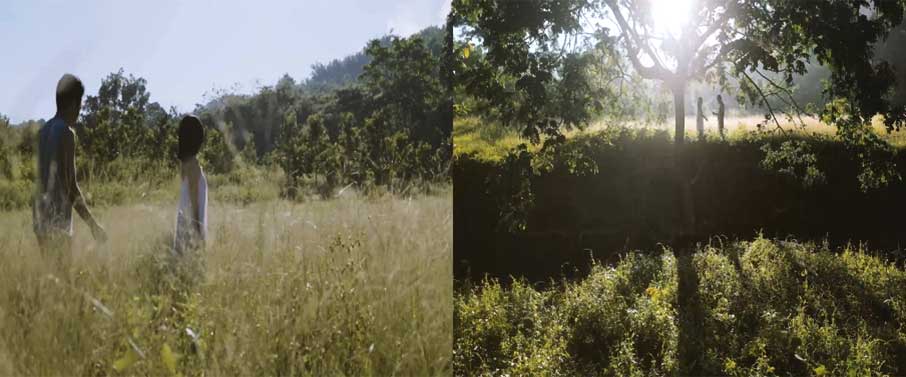
By John E. Barrios
As a short film that addresses two different spaces—the city and the barrio—Sa Taguangkan sang Duta has a clear message to the audience: that the barrio is the place of happiness and abundance. It is reflected in the contrast between the two spaces, in leaving and forgetting, and in presenting memory as a source of power.
From the direction of Emmanuel Lerona, and based on the Palanca-winning short story by Alice Tan-Gonzales, produced by Julie Prescott, the adaptation of the short story into a short film is a project that attempts to put the binary opposition—city and barrio—into discourse. The film had its premiere on April 27, 2024 at the UPV Cinematheque in Iloilo City.

The film opens with the first space, the city of Iloilo, presented as chaotic and in need of cleaning and vacating. The first scene shows an act of cleaning. Elena (Alyanna Cortum), a teacher who was not given a permanent position (in the original version she was a jeweler who was not given a promotion), put her belongings (a certificate, lesson plans, pens and coloring materials, a globe, paper plane, and a clothe embroidered with the image of a tree and flowers) in a box as she bids goodbye to her co-teacher. Then, the audience can see Elena’s spotless desk. This is followed by the scene of her leaving where she is riding the bus going back home to the barrio of San Raphael. The viewers will see the images (from the point of view of Elena looking out from the bus’s window) of the city: the concrete houses, buildings, cars, and people moving fast, until this was finally replaced by the image of the barrio: farms, fields, woods, and mountains.
The barrio, at first glance, appears as a romanticized space, prosperous and tranquil. But the space of the barrio, despite being clean and spacious, shares some similarity to that of the city. Due to the penetration of capitalism and the people’s need for their livelihood, the trees had to be knocked down, sawn, and sold in the city by the family of Andoy (Barry Matthew Namo), Elena’s husband. The color of the barrio is gradually becoming like the color of the earth. The barrio is starting to get ugly and dangerous because its trees are being cut down. With Elena’s discovery of this, she realized that the space she exchanged for the city was no different: that what she had wanted to forget is what she has found and still have to face.
Thus, Elena needed to get strength from the past, from her memory; she had to look back from the time of her Lolo Matias, the time when it could be said that the babaylan were trusted and considered powerful by the community. This power is manifested in her display of appreciation of plants, taking care of them, and planting collected batwan seeds. And so, comes one night, when she remembered her Lolo’s act of planting seeds naked under the full moon at dawn. She prepared the tools and seeds and woke her sleeping husband up and led him to the fields. There, she made her husband undress and ordered him to plant the seeds under the waning moon.

The silhouette of her husband with fully erect penis planting the seeds during a foggy dawn can be read as a unification of meaning of both the agricultural and sexual practice related to the production of life, both of earth and of humanity. This image’s narrative has its continuation in the next scene where the husband and wife had sexual intercourse—an act that cannot be separated from planting: planting seeds is synonymous to procreation. The woman and the land became one. The woman as the taguangkan (womb) of the earth. And this identity gave life and color to the identity of woman: woman as flower, plant, water, and earth, as shown after they have reached sexual climax.

On the other hand, it can be said that the topography of the barrio is not only geographical. Elena’s use of her memory of her grandfather’s planting practice and her return to the precolonial agricultural belief systems re-enact the barrio’s cultural practice in the topography of the imaginary. This excavated imaginary made Elena to negotiate precolonial worldview with modern rationality, which is the beginning and end of nature’s destruction.
In addition, it can be said that Elena’s negotiation dissolves the border between the city and the barrio. For, there really is no topographical border because the structure of Elena’s reasoning was constructed by the city where she studied and worked as a professional teacher. It comes as no surprise because after the problem was negotiated, Elena encouraged her husband to continue his studies, which means that the negotiation with the city as space also continues. Now, the diminished boundaries between the city and the barrio—the modern and pre-modern knowledge—is wholly written.

At the end of the story of the film Taguangkan, Elena had to let go of a decision not to return to the city and to promise to help the husband to set-up a livelihood in the barrio, and at the same time strive to protect the environment. With her equal, her husband, these creatures will take care of the future of our world and to revive what was once called ‘Paradise’.
John E. Barrios is a Professor at the Division of Professional Education, College of Arts and Sciences, University of the Philippines Visayas. He teaches Filipino, Art Appreciation, and Research classes.






















